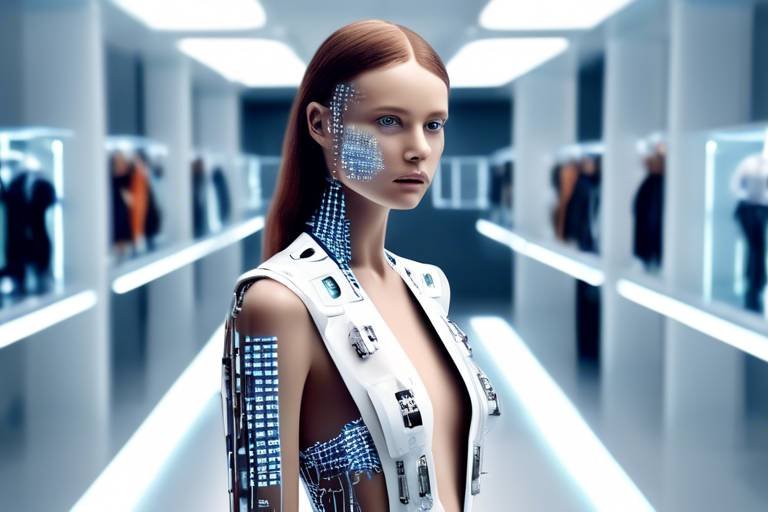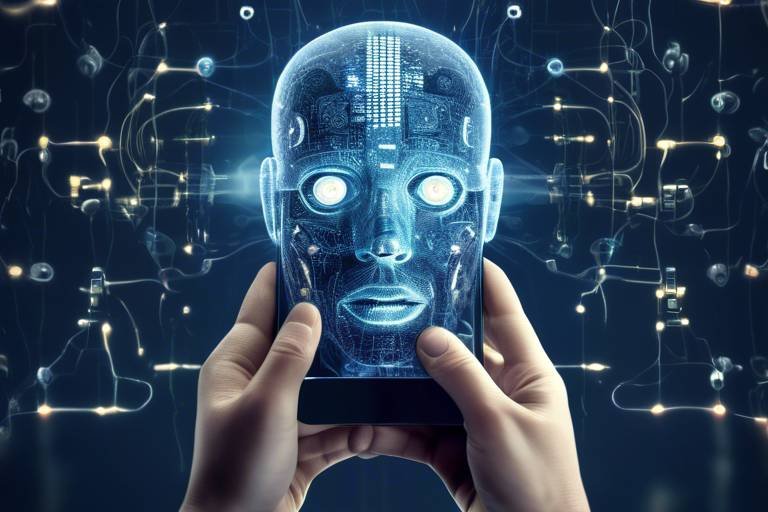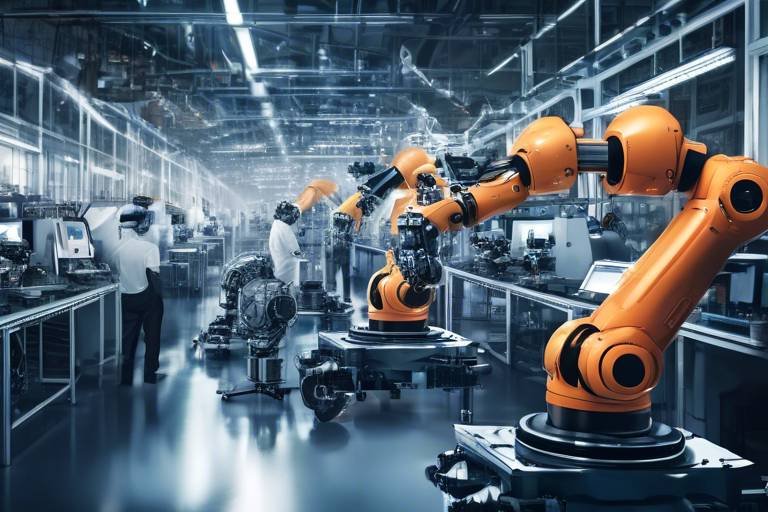Artificial Intelligence in the Fitness Industry: What Lies Ahead
As we stand on the brink of a technological revolution, artificial intelligence (AI) is poised to redefine the fitness industry in ways we could only dream of a decade ago. Imagine walking into a gym where the equipment knows your name, your fitness level, and your goals. Sounds like science fiction, right? Yet, this is quickly becoming our reality. AI is not just a trend; it’s a transformative force that is reshaping how we approach fitness, training, and wellness. From personalized training programs to nutrition planning, AI is becoming an integral part of our fitness journeys.
In recent years, we’ve witnessed a surge in AI applications within the fitness realm. Fitness enthusiasts and professionals alike are leveraging AI to enhance performance, track progress, and even motivate individuals to push their limits. But what does the future hold? With advancements in technology and a growing understanding of user behavior, the possibilities seem endless. In this article, we will explore the current applications of AI in fitness, delve into future trends, and discuss the challenges that come with integrating these technologies into our daily routines.
So, what exactly is happening right now in the fitness industry? Well, AI is already making significant strides by offering personalized training experiences, where algorithms analyze data to create tailored workout plans that adapt to individual needs. This level of customization not only enhances user engagement but also leads to better results. Imagine having a personal trainer available 24/7, who knows exactly how you respond to each workout and adjusts your routine accordingly. That’s the magic of AI!
Furthermore, data-driven insights powered by AI analytics are changing the way we view our fitness journeys. Users can now receive actionable feedback based on their performance metrics, helping them make informed decisions about their training. It’s like having a coach in your pocket, guiding you every step of the way. But it doesn’t stop there; the integration of adaptive learning in fitness apps means that these tools can learn from user interactions, continually refining and improving the workout experience.
As we look to the future, we can expect to see an explosion of innovative trends, including advanced wearables that not only track your movements but also offer real-time adjustments to your workouts. Imagine a smartwatch that not only counts your steps but also suggests when to increase your pace or modify your form. Additionally, AI-driven nutrition planning will become increasingly sophisticated, analyzing dietary preferences and health goals to create optimized meal plans that fuel your fitness journey.
However, with great power comes great responsibility. The implementation of AI in fitness is not without its challenges. Issues such as data privacy concerns and technology accessibility must be addressed to ensure that everyone can benefit from these advancements. As we navigate this new landscape, it’s essential to strike a balance between leveraging technology and maintaining user trust.
In conclusion, the role of AI in the fitness industry is not just a passing fad; it’s a fundamental shift that is set to revolutionize how we approach health and wellness. As we embrace this change, we must also remain vigilant about the challenges that come with it. The future of fitness is bright, and with AI leading the charge, we can look forward to a more personalized, engaging, and effective fitness experience.
- What is AI in the fitness industry? AI in fitness refers to the use of artificial intelligence technologies to enhance workout experiences, provide personalized training, and analyze performance data.
- How does AI personalize workout plans? AI analyzes individual fitness levels, goals, and performance data to create customized workout plans that adapt as users progress.
- What are the benefits of AI in nutrition planning? AI can analyze dietary preferences and health goals to generate optimized meal plans, making it easier for individuals to maintain a balanced diet.
- What challenges does AI face in fitness? Key challenges include data privacy concerns, technology accessibility, and overcoming user skepticism regarding AI's effectiveness.

Current Applications of AI in Fitness
Artificial Intelligence is not just a buzzword; it’s a game-changer in the fitness industry. Imagine walking into a gym where the equipment knows your name and your workout history! That’s the reality we’re stepping into. Today, AI is revolutionizing the way we approach fitness, making workouts more personalized, efficient, and engaging. From personalized training programs to virtual coaching, the integration of AI is transforming traditional fitness paradigms.
One of the most exciting applications of AI in fitness is the development of personalized training programs. These programs leverage algorithms that analyze individual fitness levels, goals, and preferences. For instance, if you're a beginner looking to lose weight, AI can create a tailored workout plan that gradually increases in intensity as you progress. Such personalization not only keeps you motivated but also maximizes your results. In fact, studies have shown that personalized training can lead to a 30% increase in workout adherence.
In addition to personalized training, AI is also enhancing the experience of virtual coaching. With the rise of fitness apps and online platforms, users can now access coaching from the comfort of their homes. AI-driven virtual coaches can provide real-time feedback during workouts, ensuring that users maintain proper form and technique. This is particularly beneficial for those who might feel intimidated in a gym setting. Imagine having a coach who’s available 24/7, ready to guide you through every squat and push-up!
Moreover, AI is harnessing the power of data analytics to deliver insights that were previously unimaginable. By collecting data from wearables and fitness trackers, AI can analyze your performance trends over time. For example, if you consistently struggle with a specific exercise, the AI can suggest modifications or alternative workouts to address those weaknesses. This data-driven approach not only helps you understand your progress but also informs your training decisions, making each session more effective.
To illustrate the impact of AI in fitness, let’s take a look at a table summarizing the key applications:
| Application | Description | Benefits |
|---|---|---|
| Personalized Training Programs | AI creates tailored workout plans based on user data. | Increased motivation and better results. |
| Virtual Coaching | Real-time feedback from AI-driven coaches. | Improved form and technique, accessible anytime. |
| Data Analytics | Analyzes performance trends and suggests adjustments. | Enhanced understanding of progress and training effectiveness. |
As we dive deeper into the digital age, the applications of AI in fitness will only continue to grow. From smart gym equipment that adjusts to your capabilities to apps that offer comprehensive health and wellness advice, the future looks bright. It’s like having a personal trainer, nutritionist, and motivational coach all rolled into one, right in your pocket!
In conclusion, the current applications of AI in the fitness industry are not just about convenience; they are about creating a more engaging and effective workout experience. As we embrace these technologies, we are not only enhancing our fitness journeys but also paving the way for a healthier future.
- What is AI's role in personalized training? AI analyzes individual fitness data to create tailored workout plans that suit personal goals and levels.
- How does virtual coaching work? AI-driven virtual coaches provide real-time feedback and guidance during workouts, making fitness more accessible.
- What are the benefits of data analytics in fitness? Data analytics helps users understand their performance trends and make informed adjustments to their training.

Future Trends in AI Fitness Technology
As we look ahead, the fitness industry is poised for a remarkable transformation driven by the advancements in artificial intelligence. From sophisticated wearables to immersive virtual environments, the future of fitness technology is not just about tracking steps or calories; it's about creating a holistic approach to health and wellness. Imagine a world where your fitness journey is guided by a virtual coach that understands your body better than you do. This is not science fiction; it's the future we're heading towards!
One of the most exciting trends on the horizon is the rise of advanced wearables. These devices will go beyond simple heart rate monitoring or step counting. Picture a smartwatch that not only tracks your activity but also analyzes your sleep patterns, stress levels, and even your hydration needs. As these wearables become more sophisticated, they will provide real-time feedback and suggestions tailored specifically to your unique physiological responses. This level of personalization will help users optimize their workouts and recovery periods, ultimately leading to better results.
In addition to wearables, AI-driven nutrition planning is set to revolutionize how we approach our diets. Imagine an app that not only tracks your meals but also analyzes your nutritional intake against your fitness goals. It could suggest meal plans, recipes, and even grocery lists based on your preferences and dietary restrictions. This technology will empower users to make informed choices, ensuring that their nutrition aligns seamlessly with their fitness objectives. It's like having a personal nutritionist in your pocket!
Moreover, the concept of immersive virtual reality workouts is gaining traction. Imagine stepping into a virtual gym where you can train alongside others from around the globe, all while being guided by an AI coach that adjusts the intensity based on your performance. This immersive experience not only makes workouts more engaging but also helps in maintaining motivation. The ability to train in a virtual environment can break the monotony of traditional workouts and offer a sense of community, making fitness more enjoyable.
At the heart of these trends is the idea of personalized training experiences. AI's ability to analyze vast amounts of data allows it to create customized workout plans that cater to individual fitness levels and goals. This means that whether you're a seasoned athlete or just starting your fitness journey, AI can design a program that challenges you appropriately. Personalization not only enhances user engagement but also significantly improves results, as workouts are tailored to push you just enough to achieve your desired outcomes.
Furthermore, utilizing data-driven insights can transform the way users approach their fitness routines. AI can provide actionable feedback based on performance metrics, helping individuals understand what works best for them. For instance, if a user notices a plateau in their progress, AI can analyze their workout history and suggest adjustments to break through that barrier. This type of adaptive learning ensures that users are always progressing and not stuck in a rut.
Speaking of adaptive learning, AI-powered fitness apps are becoming smarter every day. These apps can learn from user interactions, adapting workouts in real-time based on performance and feedback. If you're struggling with a particular exercise, the app can modify it to better suit your current ability. This dynamic approach keeps users engaged and helps them achieve their fitness goals without feeling overwhelmed.
As we've touched on earlier, nutrition plays a crucial role in fitness, and AI is stepping up to the plate. By analyzing dietary preferences and health goals, AI can help create optimized meal plans that not only nourish the body but also support fitness objectives. This means that users can enjoy delicious meals while still staying on track with their health goals.
In conclusion, the future of AI in the fitness industry is incredibly promising. With advanced wearables, AI-driven nutrition planning, and immersive virtual reality workouts, the possibilities are endless. As technology continues to evolve, we can expect a more personalized, engaging, and effective fitness experience that caters to the needs of every individual.
- What are the benefits of AI in fitness? AI provides personalized training plans, real-time feedback, and data-driven insights that enhance user engagement and results.
- Will AI replace personal trainers? While AI can offer valuable insights and guidance, personal trainers provide a human touch that many users find essential for motivation and support.
- How does AI ensure data privacy? Reputable fitness apps implement stringent security measures to protect user data, ensuring that personal information is kept confidential.
- Are AI fitness technologies accessible to everyone? While technology is advancing, there are still challenges regarding accessibility, particularly for those without access to high-end devices or the internet.

Personalized Training Experiences
Imagine walking into a gym where every piece of equipment knows your name, your fitness level, and your personal goals. This is not just a futuristic dream; it’s becoming a reality thanks to artificial intelligence (AI). AI is revolutionizing the way we approach fitness by providing that are tailored specifically to individual needs. This level of customization goes beyond merely adjusting weights or reps; it encompasses a holistic view of a person's health and fitness journey.
At the core of personalized training is the ability of AI to analyze vast amounts of data. By collecting information from various sources—such as wearable devices, fitness apps, and user feedback—AI can create a unique profile for each individual. This profile includes factors like current fitness level, exercise preferences, and even injury history. With this data, AI can develop a workout plan that not only challenges the user but also keeps them engaged and motivated.
One of the most exciting aspects of AI-driven personalized training is its ability to adapt in real-time. For instance, if a user is struggling with a particular exercise, the AI can instantly modify the workout to better suit their capabilities. This adaptability ensures that users are always working within their optimal challenge zone, which is crucial for progress. Think of it as having a personal trainer who is not only present during your workout but is also able to analyze your performance and make adjustments on the fly.
Furthermore, the integration of AI in fitness apps allows for a more interactive experience. Users can receive instant feedback on their performance, track their progress over time, and even set new goals based on their achievements. This continuous loop of feedback and adjustment fosters a sense of accountability and encourages users to stay committed to their fitness journey.
Here are some key benefits of personalized training experiences powered by AI:
- Enhanced Engagement: Custom workouts keep users interested and motivated.
- Improved Results: Tailored plans lead to better performance and quicker progress.
- Injury Prevention: AI can help identify exercises that may pose a risk based on individual history.
In conclusion, personalized training experiences enabled by AI are changing the landscape of fitness. By leveraging data, adapting in real-time, and providing continuous feedback, AI not only enhances the user experience but also drives better results. As we move forward, the potential for AI in fitness is limitless, promising even more innovative solutions to help individuals achieve their health and fitness goals.
1. How does AI create personalized workout plans?
AI analyzes various data points, such as fitness levels, preferences, and goals, to tailor a workout plan that suits the individual best.
2. Can AI adapt my workout in real-time?
Yes! AI can monitor your performance during workouts and make adjustments as needed to ensure you’re always challenged but not overwhelmed.
3. Is my personal data safe with AI fitness apps?
While AI fitness apps collect a lot of data, reputable ones implement strong security measures to protect your personal information. Always check their privacy policies!
4. Do I need special equipment to use AI in my workouts?
Not necessarily! Many AI fitness apps work with standard equipment or even bodyweight exercises, making them accessible to a wide range of users.

Data-Driven Insights
In the world of fitness, data is the new gold. With the rise of artificial intelligence, we're witnessing a significant shift in how fitness enthusiasts and professionals alike can leverage to enhance their training regimens. Imagine having a personal coach who not only motivates you but also analyzes every aspect of your performance—this is precisely what AI brings to the table. By analyzing data collected from various sources, including wearable devices and mobile fitness apps, AI can provide users with actionable insights that are tailored to their unique fitness journeys.
For instance, when you complete a workout, AI algorithms can evaluate your performance metrics such as heart rate, calories burned, and even your form. This analysis allows for real-time feedback, enabling you to make immediate adjustments to your routine. It's similar to having a mirror that not only reflects your physical state but also offers suggestions on how to improve. The ability to make data-informed decisions can significantly enhance your training outcomes, leading to faster progress and better overall results.
Moreover, these insights aren't just limited to performance metrics. AI can also analyze patterns over time, identifying trends in your workouts, recovery periods, and even your nutrition. This means that if you're consistently underperforming or feeling fatigued, AI can suggest modifications to your training schedule or dietary changes to optimize your performance. The potential for personalized coaching is immense, as it allows for a deeper understanding of what works best for each individual.
To illustrate this point, let's consider a simple table that shows how AI can break down data into actionable insights:
| Metric | AI Analysis | Actionable Insight |
|---|---|---|
| Heart Rate Variability | Indicates recovery status | Adjust workout intensity based on recovery |
| Workout Completion Rate | Tracks consistency | Suggests rest days or alternative exercises |
| Caloric Intake vs. Burned | Analyzes dietary balance | Recommends meal adjustments for energy levels |
This table showcases just a few examples of how AI can convert raw data into meaningful insights that can propel your fitness journey forward. The beauty of such technology lies in its adaptability; the more data it collects, the better it becomes at understanding your specific needs and preferences. As a result, users can expect a workout experience that evolves with them, making fitness not just a routine but a personalized adventure.
However, it's essential to acknowledge that while the benefits of data-driven insights are substantial, users must also consider how to interpret and implement these insights effectively. The information provided by AI should serve as a guide rather than an absolute directive. After all, every individual is unique, and what works for one person may not necessarily work for another. Thus, a collaborative approach between user and technology is vital for achieving the best possible outcomes.
As we continue to explore the intersection of AI and fitness, it's clear that the future holds exciting possibilities. With ongoing advancements in technology, we can expect even more sophisticated data analytics that will further enhance the way we approach our fitness goals. It's an exhilarating time to be part of this evolution, where data doesn't just inform our choices but actively shapes our fitness journeys.
- What is data-driven fitness? Data-driven fitness refers to the use of data analytics and insights to inform and optimize workout routines and nutrition plans.
- How does AI enhance my workout experience? AI provides personalized feedback and recommendations based on your performance data, helping you to achieve better results.
- Are my personal data safe when using AI fitness apps? Most reputable AI fitness apps prioritize user privacy and employ robust security measures to protect your personal information.
- Can AI help with nutrition planning? Yes, AI can analyze your dietary preferences and health goals to create optimized meal plans tailored to your needs.

Adaptive Learning in Fitness Apps
Imagine walking into a gym where every piece of equipment knows exactly how you like to work out. Sounds futuristic, right? Well, thanks to adaptive learning in fitness apps, this is becoming a reality. These cutting-edge applications utilize artificial intelligence to analyze your workout habits and preferences, creating a truly personalized experience. As you progress, the app learns from your interactions, adjusting your workouts in real-time to keep you challenged and engaged.
One of the most exciting aspects of adaptive learning is its ability to tailor workouts based on your physical condition and feedback. For instance, if you consistently struggle with a particular exercise, the app might suggest modifications or alternative movements to help you build strength gradually. This level of customization not only enhances the effectiveness of your workouts but also helps prevent injuries by ensuring that you're not pushing yourself too hard too soon.
Moreover, these apps often incorporate gamification elements, which can make your fitness journey feel more like a game than a chore. By tracking your progress and providing instant feedback, they encourage you to push your limits. You might find yourself motivated by virtual rewards, challenges, and even friendly competition with friends or a community of users. This social aspect can transform your fitness routine into a fun and engaging experience.
To give you a clearer picture, let’s look at how adaptive learning works in fitness apps:
| Feature | Description |
|---|---|
| Real-time Adjustments | The app modifies your workout based on immediate feedback, such as heart rate or perceived exertion. |
| Progress Tracking | It keeps a record of your performance, learning from each session to optimize future workouts. |
| Personalized Recommendations | Based on your goals and preferences, the app suggests exercises that align with your fitness journey. |
With the integration of adaptive learning, the future of fitness apps looks bright. Users no longer have to follow generic workout plans that may not suit their needs. Instead, they can enjoy a dynamic and responsive training experience that evolves with them. As technology continues to advance, we can expect even more sophisticated features that will push the boundaries of what personalized fitness can achieve.
In summary, adaptive learning in fitness apps is revolutionizing the way we approach our workouts. By leveraging the power of AI, these applications create a customized experience that adapts to our individual needs, ultimately helping us achieve our fitness goals more effectively. So, whether you’re a beginner or a seasoned athlete, embracing these smart technologies can be the key to unlocking your full potential in fitness.
- What is adaptive learning in fitness apps? Adaptive learning refers to the ability of fitness applications to adjust workouts in real-time based on user performance and feedback.
- How does adaptive learning improve my workouts? It personalizes your training experience, ensuring that workouts are tailored to your current fitness level and goals, which can enhance results and reduce the risk of injury.
- Are all fitness apps equipped with adaptive learning features? No, not all fitness apps have these capabilities. Look for apps that specifically advertise adaptive learning or AI-driven personalization.
- Can adaptive learning help beginners? Absolutely! Adaptive learning can provide beginners with a structured approach that evolves as they gain strength and confidence.

AI in Nutrition and Diet Planning
When it comes to achieving fitness goals, nutrition is a game changer. It's like the secret sauce that can make or break your progress. Enter Artificial Intelligence (AI), a technology that is revolutionizing how we approach diet planning. Imagine having a personal nutritionist in your pocket, one that understands your unique needs and preferences. AI does just that by analyzing your dietary habits, health goals, and even your food preferences to create tailored meal plans.
One of the most exciting aspects of AI in nutrition is its ability to adapt to your lifestyle. For instance, if you have a busy week ahead, AI can suggest quick, nutritious meals that fit your schedule. It’s like having a nutrition coach that not only understands your goals but also your daily realities. The integration of AI in diet planning is not just about tracking calories; it’s about enhancing your overall well-being.
AI algorithms can process vast amounts of data to identify patterns in your eating habits. By analyzing your past food choices and their impact on your performance, AI can offer insights that are both actionable and personalized. For example, if you consistently feel sluggish after certain meals, AI can recommend alternatives that boost your energy levels. This data-driven approach ensures that your nutrition plan evolves with you, making it more effective over time.
Moreover, AI can also help in managing dietary restrictions and preferences. Whether you’re vegan, gluten-free, or have specific allergies, AI can curate meal plans that cater to your needs. This level of customization is not just beneficial; it’s essential in today’s diverse dietary landscape. With AI, you can explore a variety of meal options without the stress of compromising your health.
To give you a clearer picture of how AI enhances nutrition planning, consider the following table that highlights key benefits:
| Benefit | Description |
|---|---|
| Personalization | AI tailors meal plans to individual needs, preferences, and goals. |
| Real-time Adjustments | Plans can be modified based on user feedback and performance metrics. |
| Accessibility | Users can access nutritional guidance anytime and anywhere via apps. |
| Data Insights | AI analyzes eating patterns to provide actionable insights for improvement. |
In summary, the future of nutrition and diet planning is bright with AI at the helm. As technology continues to advance, we can expect even more sophisticated tools that will help us navigate the complex world of food and nutrition. The integration of AI not only simplifies meal planning but also empowers individuals to make informed choices that align with their health goals. So, the next time you think about your diet, remember that AI is here to make your journey smoother and more enjoyable.
- How does AI personalize meal plans? AI analyzes individual dietary habits, preferences, and health goals to create customized meal plans.
- Can AI help with dietary restrictions? Yes, AI can curate meal plans that cater to specific dietary needs, such as vegan or gluten-free diets.
- Is AI in nutrition planning accessible to everyone? While many apps are available, access can vary based on technology and internet availability.
- What data does AI use to provide insights? AI utilizes user-inputted data, past food choices, and performance metrics to generate insights.

Challenges of Implementing AI in Fitness
While the integration of artificial intelligence in the fitness industry is exciting and offers numerous benefits, it does not come without its challenges. One of the primary hurdles is the issue of data privacy. With AI systems collecting vast amounts of personal data to tailor fitness experiences, users may feel uneasy about how their information is being used and protected. Imagine sharing your personal health metrics, workout habits, and dietary preferences, only to find out that this sensitive data could be vulnerable to breaches. As such, safeguarding user information should be a top priority for developers and fitness professionals alike.
Another significant challenge is technology accessibility. Not everyone has equal access to the latest fitness technology, which can create a digital divide. For instance, while some individuals may have the latest smartwatches or fitness apps, others may not even have access to basic internet services. This disparity can lead to unequal benefits in the fitness community, where those without access to AI tools may feel left behind. It’s crucial to consider how we can bridge this gap to ensure that everyone can enjoy the advantages of AI in fitness.
Moreover, there’s a level of user skepticism that can’t be ignored. Many individuals may question the effectiveness of AI-driven fitness programs or feel overwhelmed by the technology itself. They might wonder if a machine can truly understand their unique body and fitness journey. To combat this skepticism, fitness professionals must focus on educating users about the benefits of AI and how it can complement their personal training. Clear communication can help build trust and encourage more people to embrace these innovative tools.
To summarize, the challenges of implementing AI in the fitness industry can be categorized into three main areas:
- Data Privacy: Ensuring the protection of personal information.
- Technology Accessibility: Addressing the digital divide to ensure equal access.
- User Skepticism: Overcoming doubts about the effectiveness of AI solutions.
Addressing these challenges will require collaboration between technology developers, fitness professionals, and users to create a safe and inclusive environment that harnesses the full potential of AI in fitness.
- What are the main benefits of using AI in fitness?
AI can provide personalized training programs, real-time feedback, and data-driven insights that enhance workout efficiency and effectiveness. - How does AI ensure data privacy?
AI systems must implement robust security measures, such as encryption and anonymization, to protect user data. - Can everyone access AI fitness tools?
Access varies; efforts are needed to bridge the digital divide and make technology available to all. - What can be done to overcome user skepticism about AI?
Education and transparent communication about how AI works and its benefits can help build trust among users.

Data Privacy Concerns
As we plunge deeper into the age of artificial intelligence in the fitness industry, one of the most pressing issues that arises is data privacy. With fitness apps and devices collecting vast amounts of personal data—from our workout routines to our heart rates and even our dietary habits—users are increasingly concerned about how this information is being used and protected. It's akin to handing over the keys to your home; you want to ensure that the person you’re trusting with those keys has your best interests at heart.
Many users may not realize the extent of the data being collected. For instance, a typical fitness app might track:
- Your location during workouts
- Your workout history and performance metrics
- Your personal health information, such as weight, age, and medical conditions
- Your dietary preferences and restrictions
This begs the question: how secure is this information? Are fitness companies doing enough to protect user data from breaches or unauthorized access? The reality is that while many companies are implementing robust security measures, there are still vulnerabilities that can be exploited. For instance, a data breach can expose sensitive personal information, leading to identity theft or other malicious activities.
Moreover, the transparency of data usage is another critical factor. Users often find themselves in a maze of terms and conditions that are difficult to navigate. Many may agree to data collection without fully understanding what they are consenting to. This lack of clarity can foster a sense of distrust among users, making them wary of adopting AI-driven fitness solutions.
To address these concerns, companies in the fitness sector must prioritize data privacy by:
- Implementing strong encryption methods to protect user data.
- Providing clear and concise privacy policies that explain how data will be used.
- Offering users the ability to control their data, including options to delete it when desired.
As the fitness industry continues to embrace AI technology, it is essential for both developers and users to engage in an open dialogue about data privacy. This conversation will not only help build trust but also ensure that the benefits of AI can be enjoyed without compromising personal security. After all, the goal of integrating AI into fitness is to enhance our health and well-being, not to create additional stress about our privacy.
Q: What kind of data do fitness apps typically collect?
A: Fitness apps often collect data such as workout history, heart rate, location, personal health information, and dietary preferences.
Q: How can I protect my data when using fitness apps?
A: You can protect your data by choosing apps with strong privacy policies, using encryption, and regularly reviewing the permissions you grant to the app.
Q: Are all fitness apps secure?
A: Not all fitness apps are equally secure. It’s crucial to research and choose apps from reputable companies that prioritize data protection.
Q: Can I delete my data from fitness apps?
A: Most fitness apps allow you to delete your account and personal data, but it’s important to check the app’s privacy policy for specific instructions.

Technology Accessibility
When we talk about the fitness revolution brought about by artificial intelligence, it's easy to get swept up in the excitement of cutting-edge technology. However, a crucial question looms large: who really has access to these advancements? The reality is that while AI-powered fitness solutions are transforming how we approach health and wellness, there remains a significant gap in technology accessibility that cannot be ignored.
Imagine a world where everyone, regardless of their background or resources, can take advantage of personalized training programs and nutrition plans. Unfortunately, this vision is still far from reality. Many individuals, especially in underserved communities, face barriers that prevent them from accessing the latest AI fitness technologies. These barriers can include financial constraints, lack of internet connectivity, and limited access to devices that support advanced applications.
To illustrate this disparity, consider the following factors that contribute to the digital divide in fitness technology:
- Cost of Technology: Advanced fitness wearables and apps often come with a hefty price tag, making them inaccessible to many.
- Internet Connectivity: In some areas, reliable internet access is a luxury, which limits the ability to utilize cloud-based fitness solutions.
- Device Compatibility: Not everyone has access to the latest smartphones or computers that can run sophisticated fitness applications.
Moreover, the challenge extends beyond mere access to technology. Even when individuals have the tools at their disposal, digital literacy plays a vital role. Many potential users may not feel comfortable navigating complex applications or interpreting the data provided by AI algorithms. This lack of familiarity can lead to frustration and disengagement, ultimately undermining the benefits that AI in fitness has to offer.
As we look to the future, it’s essential for developers and fitness professionals to address these accessibility issues head-on. Solutions could include:
- Affordability Initiatives: Offering tiered pricing models or free access to basic features can help bridge the gap.
- Community Programs: Local fitness centers could partner with tech companies to provide access to AI tools for community members.
- Education and Training: Workshops that teach users how to effectively use fitness technology can empower more individuals to engage with these tools.
In conclusion, while the potential for AI in the fitness industry is vast, it’s imperative that we don’t leave anyone behind. By addressing the challenges of technology accessibility, we can ensure that the benefits of artificial intelligence are enjoyed by all, paving the way for a healthier and more inclusive future.
- What are the main barriers to accessing AI fitness technology? The primary barriers include cost, internet connectivity, and device compatibility.
- How can communities improve access to fitness technology? Communities can implement affordability initiatives, partner with tech companies, and provide educational workshops.
- Why is digital literacy important in using AI fitness tools? Digital literacy ensures that users can effectively navigate and utilize the technology, maximizing its benefits.
Frequently Asked Questions
- What is the role of AI in personalized training?
AI plays a pivotal role in creating tailored workout plans that cater to individual fitness levels and goals. By analyzing user data, AI can suggest exercises that fit your unique needs, making your fitness journey more engaging and effective.
- How does AI enhance nutrition and diet planning?
AI can analyze your dietary preferences and health goals to create optimized meal plans. This means you get personalized nutrition advice that aligns with your fitness objectives, helping you achieve better results faster.
- What are the current applications of AI in fitness?
Currently, AI is being utilized for personalized training programs, virtual coaching, and data analytics. These applications help users track their progress and receive real-time feedback, making workouts more efficient and enjoyable.
- What challenges does AI face in the fitness industry?
While AI offers many benefits, challenges such as data privacy concerns, technology accessibility, and user skepticism can hinder its widespread adoption. It's crucial to address these issues to ensure a safe and inclusive fitness environment.
- How does AI provide data-driven insights?
AI utilizes data analytics to deliver actionable insights based on your performance. This allows you to make informed training adjustments, enhancing your overall workout effectiveness and helping you reach your goals more efficiently.
- What is adaptive learning in fitness apps?
Adaptive learning in fitness apps means that the application can learn from your interactions and adjust workouts in real-time. This feature ensures that your training remains challenging yet achievable, keeping you motivated and on track.
- Are there privacy concerns with AI in fitness?
Yes, with AI collecting vast amounts of personal data, privacy concerns are valid. It's essential for fitness applications to implement robust security measures to safeguard user information and maintain trust.
- How does technology accessibility impact AI adoption in fitness?
Not everyone has equal access to advanced fitness technology, which can create a digital divide. This disparity may limit the adoption of AI tools in fitness, making it important to find ways to bridge this gap for a more inclusive experience.



















